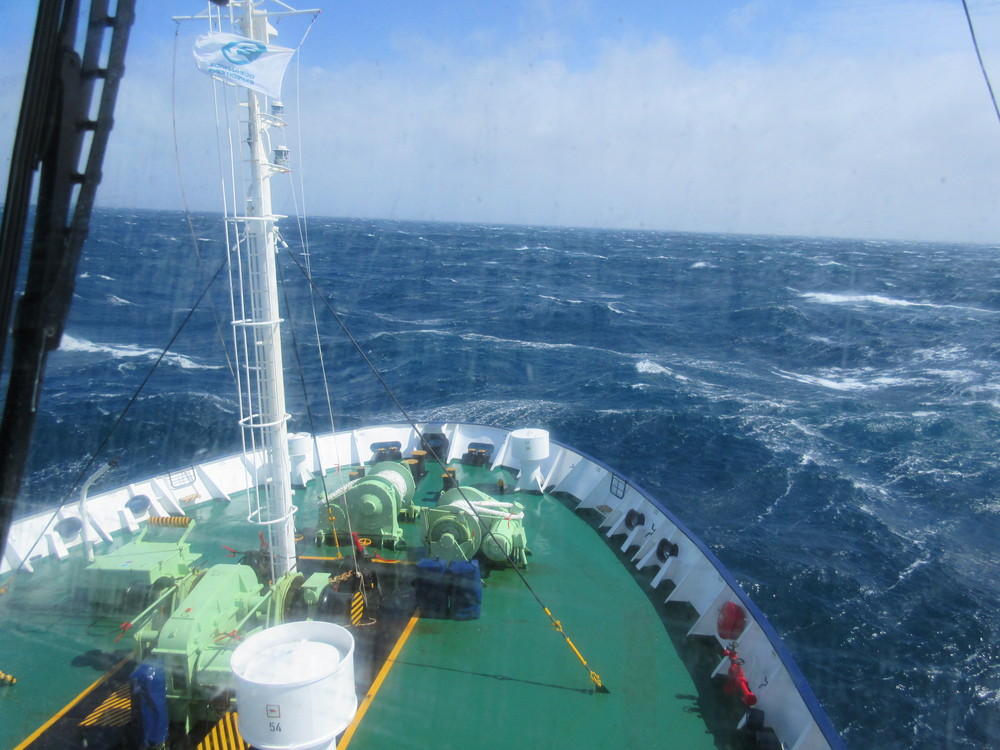HEAVY WEATHER IN THE SCOTIA SEA (27-30 December 2014)
 After breakfast we hope for calm conditions to allow for one last South Georgia landing
at Cooper Bay. The weather did not cooperate.
The captain closes the outside decks to passengers shortly after
breakfast.
Fortunately, the bridge remains open to passengers, and we spend
many hours up there over the next few days.
After breakfast we hope for calm conditions to allow for one last South Georgia landing
at Cooper Bay. The weather did not cooperate.
The captain closes the outside decks to passengers shortly after
breakfast.
Fortunately, the bridge remains open to passengers, and we spend
many hours up there over the next few days.
We have 70 knot sustained winds at Cooper Bay and gusts of 90 knots later
as we near the entrance to Drygalski Fjord.
We encounter the Polar Explorer just outside Drygalski Fjord,
and it looks like they are going to try to cruise the fjord.
They are a bit smaller than us (52 passengers), so they might
make it, but our staff doesn't give them much chance.
There's a low pressure system sitting pretty much right where
we want to go. We're in for high winds and high seas. It
looks like our next planned stop at Elephant Island is unlikely,
and we are heading for the South Orkneys instead.
We have 65 knot winds 30-45 degrees
off the starboard bow the whole way. For most of the day
we're only making 3.5 knots. We don't get very far.
Enormous sprays occasionally crash over the bow. Every once in
a while we take water through the holes for the anchor chain
and it sloshes around on the bow for a while. In the afternoon,
from our room on Deck 5, from time to time the horizon
is blocked by waves. It's looking pretty much like a Class "A"
storm. But by going only 3.5 knots, we reduce the rocking and
rolling. This safety measure may keep
someone from breaking a leg or a neck in a stairwell or shower.
The ship makes a fairly load "BANG" on many of the forward
pitches, as it belly flops into the next wave. On many of them
a secondary shuddering vibration runs through the ship,
 Nevertheless, the crew's body language is very relaxed. We watch
the captain for a few minutes on the bridge - hands in pockets,
feet shoulder-width apart, excellent posture, bending only at the
angles 20-degrees forward - 20 degrees back ... After a minute
or two, he reaches forward and touches the rail for support.
Nevertheless, the crew's body language is very relaxed. We watch
the captain for a few minutes on the bridge - hands in pockets,
feet shoulder-width apart, excellent posture, bending only at the
angles 20-degrees forward - 20 degrees back ... After a minute
or two, he reaches forward and touches the rail for support.
Pauline seems to think the ship is handling well in these seas.
She says "It's nice to experience this kind of weather from
behind glass". I ask if they would normally seek a safe harbor
in these conditions. She says "If one's available". They sailed
Curlew through something like this only once.
The daily briefing we receive on our second day of rough seas begins:
"The force 11 gale that we are experiencing today with wind gusts up to
90 kts, should subside tomorrow ...." John and I are actually enjoying
the roller-coaster ride from the bridge and I have to avoid loud
exclamations of "WHEEEEEEEE!" as the ship goes up and down and waves
crash over the front of the bridge. That could get us evicted from the
bridge, but we are having a great time and not experiencing any sea-sickness.
Walking, on the other hand, can be a challenge and we try to hold onto a
railing when possible or make short lunges from point A to B in those places
where no railing exists.
More lectures are scheduled to fill time each day. We advance to using
watercolors in Marybee's drawing class. Passenger's busily edit their
photos to be submitted for a group slide-show, and a second round of
bio-security in preparation for our landings in Antarctica is completed.
|